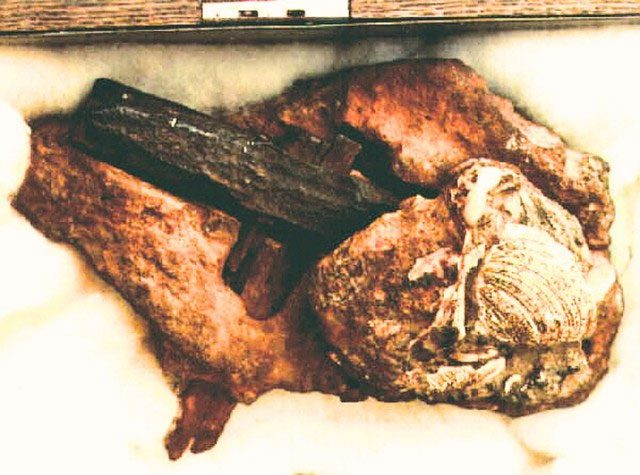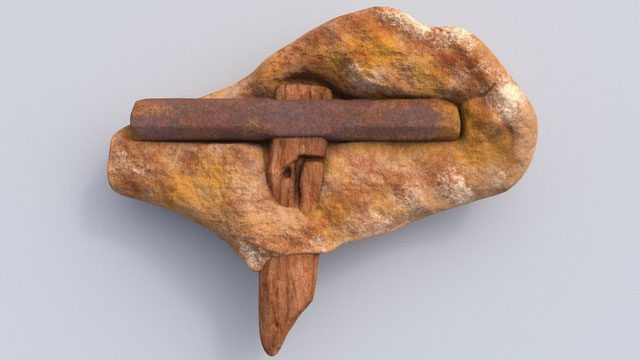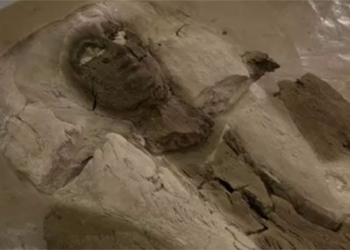The London Hammer is a hammer believed to be 115 million years old, discovered in Texas, USA in 1936. This hammer has been the subject of heated debate for decades due to its incredible age, which contradicts the theory of human evolution.
In the chronicle of strange discoveries, “The London Hammer” is considered a particularly fascinating case, sparking controversy and interest for many years. In June 1936, Emma Zadie Hahn and her husband Max Edmond Hahn stumbled upon a strange artifact while walking along Red Creek in the town of London, Texas – a piece of wood protruding from what appeared to be an ancient rock.
The intrigue began about a decade later when their son became curious about the artifact and decided to break open the stone to see what was inside. Upon breaking the stone, they discovered a hammer – a distinctly modern-looking hammer, which only added to the peculiarity of this find. A fragment of the broken stone remained intact, displaying a layer of mollusk shell that had not undergone the fossilization process, partially embedded within it.
But how could a seemingly modern tool be situated within a geological context dating back millions of years? This question has spurred numerous theories, including some suggesting that the hammer is evidence of advanced ancient civilizations or even time travel.

The age of the hammer is estimated based on the age of the stone it was found in. This stone is believed to belong to the Cretaceous period, approximately 115 million years old. This makes the hammer a mystery since it contradicts the theory of human evolution, with modern humans appearing only around 200,000 years ago.
Carl Baugh, who purchased the artifact around 1983 and publicly introduced it as the “London Artifact” when he opened his Creation Evidence Museum in 1984, asserted that the stone surrounding the hammer dates back to the Cretaceous period – implying that anyone who dropped the hammer, designed in a 19th-century style, may have done so while fleeing from a T-Rex.
Elsewhere, Baugh claimed that the stone was from the Ordovician period, suggesting the hammer was lost at a time when mollusks and arthropods dominated the oceans around 450 million years ago.
Regardless, Baugh regarded this as evidence that the theory of evolution is incorrect.

The hammer was discovered by Emma Zadie Hahn and her husband Max Edmond Hahn in 1936. While walking along Red Creek in London, Texas, they noticed a piece of wood protruding from a rock. When their son broke the rock, they were astonished to find a hammer that looked completely modern inside. Many theories have been proposed to explain the mystery of the London Hammer. Some believe the hammer is evidence that humans appeared much earlier than previously thought. Others claim the hammer is a relic of a forgotten advanced civilization. However, the most popular theory today is that the hammer is a product of a hoax.
Numerous studies have been conducted to determine the origin and age of the London Hammer. Some studies suggest that the hammer could be a modern product manufactured to deceive people. Other studies indicate that the hammer may be an ancient artifact, but its dating is not as accurate as claimed.
In 1997, researcher Glen J. Kuban published a paper in the journal Paleo, in which he provided an explanation for the mystery of the London Hammer. Kuban argued that the hammer could have been dropped by a local person in the last few hundred years. Subsequently, the hammer became encased in a limestone block due to natural processes. He cited researcher John Cole from the NCSE, who pointed out that minerals dissolved from ancient layers can harden around a modern object:
“This rock is real and looks very impressive to those unfamiliar with geological processes. How could a modern artifact get stuck in Ordovician rock? The answer is that the deposition itself is not Ordovician. Minerals in solution can harden around an infiltrating object that falls into a crack or is simply left on the ground if the parent rock (in this case, Ordovician) chemically dissolves.” (Cole, 1985)

Numerous studies have been conducted to determine the origin and age of the hammer. Scientists have employed various techniques, including carbon isotope analysis, spectroscopy, and X-ray imaging. Although many mysteries still surround the London Hammer, it remains a significant archaeological artifact that may help us understand more about human history. The hammer also serves as a reminder that there is still much we do not know about the world around us.




















































